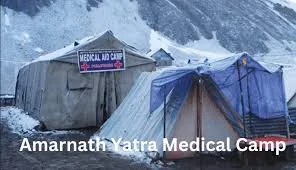The annual Amarnath Yatra is one of the most significant pilgrimages in India, attracting lakhs of devotees from across the country and abroad. Situated at an altitude of about 3,880 meters in the Himalayas of Jammu and Kashmir, the holy Amarnath Cave houses the naturally formed ice Shiva Lingam and holds immense religious importance. The Yatra primarily proceeds along two routes, the traditional and more scenic Pahalgam axis and the shorter but steeper Baltal route. The Pahalgam route, spanning approximately 48 kilometers, is favored by many yatris for its gradual ascent, natural beauty and spiritual aura. However, the challenging terrain and high altitude demand robust medical assistance and rest & recoup arrangements to ensure the safety and well-being of pilgrims.
To address the health needs of pilgrims, the Jammu & Kashmir administration, in coordination with the Shri Amarnathji Shrine Board, Indian Army, Central Reserve Police Force, Border Security Force, state health department and Non-governmental organization, has set up multiple medical camps at regular intervals along the Pahalgam route. These camps are strategically located at Chandanwari, Pissu Top, Sheshnag, Panchtarni. Each camp is equipped with primary healthcare facilities, emergency response units and trained medical staff to handle a wide range of medical issues. Many doctors and paramedics, including specialists in high-altitude medicine are deployed during the yatra season. Their presence is crucial to manage high altitude sickness, Dehydration, Hypothermia, Fractures and injuries due to slips and falls and Cardiac issues among elderly yatris. Ambulance services and emergency evacuation teams are also on standby, including air evacuation facilities provided by the Indian Air Force in critical situations.
At high-altitude points such as Sheshnag and Panchtarni, oxygen levels are low which can cause Acute Mountain Sickness. To counter this, Oxygen booths have been installed along the route. Portable oxygen cylinders and concentrators are made available and some camps are equipped with Hyperbaric Chambers to manage severe Acute Mountain Sickness. These lifesaving facilities play a key role in reducing fatalities and ensuring pilgrims can acclimatize properly. Mobile Medical Units, manned by trained personnel and equipped with basic diagnostic tools, patrol the route continuously. In case of emergencies, yatris can be quickly transported by helicopter to base hospitals in Srinagar or Anantnag. A dedicated medical helpline is active during the yatra period. Pilgrims can call for assistance, report emergencies or receive advice on health concerns. The helpline is linked to all base camps and control rooms for swift coordination.
Before being issued a yatra permit, pilgrims are required to obtain a Compulsory Health Certificate from an authorized medical center. This step ensures that only medically fit individuals undertake the arduous journey.At the base camps, yatris receive pre-yatra counseling and educational pamphlets on recognizing symptoms of Acute Mountain Sickness, importance of hydration and nutrition, maintaining a steady pace and avoiding alcohol or sleeping pills. Medical teams also oversee hygiene standards at camps and along the trek. Special attention is paid to, Clean drinking water, Proper disposal of biomedical and human waste, Preventing communicable diseases, especially during monsoon. The physically demanding nature of the Pahalgam axis makes Rest and Recoup arrangements essential. These facilities provide pilgrims with opportunities to rest, recover and continue their journey with renewed energy.
Spacious and well managed base camps have been established at Nunwan (Pahalgam base), Chandanwari, Sheshnag and Panchtarni. Each base camp provides Sleeping tents and bedding, Warm blankets and woolens, Charging points for phones and Community kitchens or “Langars”. These camps are managed by a mix of government agencies, Non-governmental organization and religious organizations.Hundreds of free Langars operate during the yatra. Pilgrims are served nutritious vegetarian meals, snacks, tea and clean drinking water. These Langars are often open 24/7 and serve as both food and rest stops. The items provided as Khichdi, dal-rice, poha, Tea, biscuits, fruits, energy drinks and glucose. Langars are also stocked with basic first-aid and warm clothing in case of emergency.
To combat unpredictable Himalayan weather, tents and shelters are made weatherproof and insulated. Emergency shelters are also built at high-risk points where snow, rain or landslides are frequent. Blankets,raincoat sand heat-retaining sleeping bags are provided especially for the elderly and those with children.Clean water stations and mobile toilets are placed at frequent intervals. Adequate lighting, sanitation staff and garbage disposal systems are in place to maintain hygiene.The Indian Army and paramilitary forces ensure the camps are secure and crowd flow is regulated. Special care is taken to protect vulnerable pilgrims, such as senior citizens, women and children.
In recent years, technology has played an important role in improving both medical and Rest & Recoup facilities, Radio Frequency Identification tracking helps monitor pilgrim movement, Closed-Circuit Television surveillance at camps aids security and emergency response, Yatra App and Portal provide real-time updates on weather, health advisories, and route status. The Pahalgam axis, while spiritually fulfilling, presents significant physical challenges due to terrain and altitude. The comprehensive medical assistance and rest & recoup arrangements ensure that devotees can complete the Amarnath Yatra with safety, dignity and devotion. The seamless coordination between government bodies, armed forces, volunteers and civil society stands as a shining example of public service and faith-based logistics. As each year passes, the administration continues to evolve its systems to make the pilgrimage safer, healthier and more spiritually enriching.


